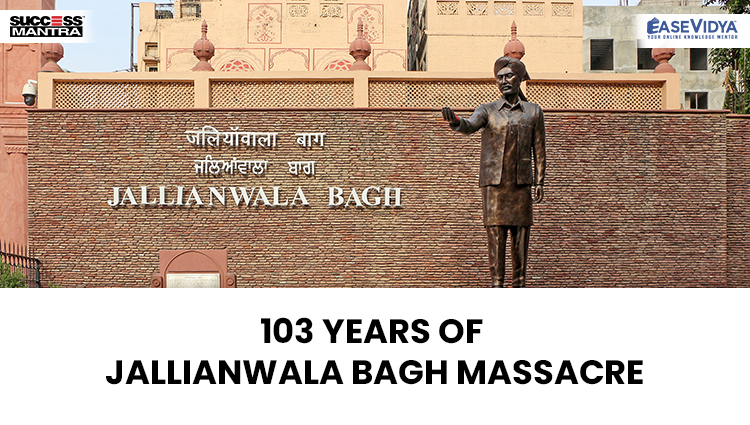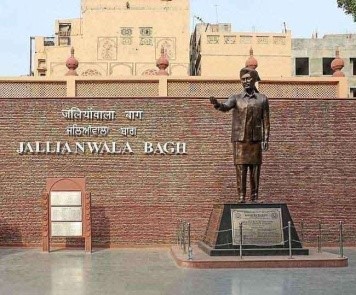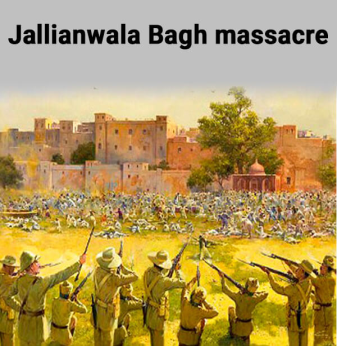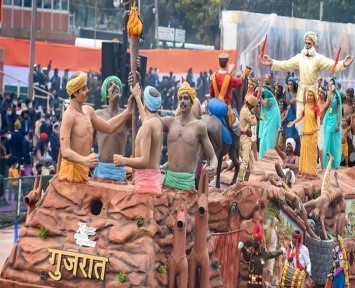
103 YEARS OF JALLIANWALA BAGH MASSACRE
103 YEARS OF JALLIANWALA BAGH MASSACRE
Recently, the Prime Minister paid tributes to people killed in the Jallianwala Bagh massacre in 1919. He asserted that their unparalleled courage and sacrifice will keep motivating the coming generations. 13th April, 2022 marks the 103 years of the incident. Earlier, the Gujarat government marked 100 years of the Pal-Dadhvav killings, calling it a massacre “bigger than the Jallianwala Bagh”.

WHAT IS THE JALLIANWALA BAGH MASSACRE?
The Jallianwala Bagh massacre or the Amritsar massacre of 13th April 1919 accounts for the gruesome execution of hundreds of innocent people by the Gurkha British Indian army on the orders of the then Anglo-Indian Brigadier R.E.H. Dyer. These people were protesting peacefully against the Rowlatt Act 1919.
WHAT WAS THE ROWLATT ACT 1919?
- During World War I (1914-18) the British government of India enacted a series of repressive emergency powers that were intended to combat subversive activities. In this context, this act was passed on the recommendations of the Sedition Committee chaired by Sir Sidney Rowlatt. It gave the government enormous powers to repress political activities and allowed detention of political prisoners without trial for two years.
- Background: Mahatma Gandhi wanted non-violent civil disobedience against such unjust laws, which would start with a hartal on 6th April 1919. In Punjab, on 9th April 1919, two nationalist leaders, Saifuddin Kitchlew and Dr. Satyapal, were arrested by the British officials without any provocation except that they had addressed protest meetings, and taken to some unknown destination. This caused resentment among the Indian protestors who came out in thousands on 10th April to show their solidarity with their leaders. To curb any future protest, the government put martial law in place and law and order in Punjab was handed over to Brigadier-General Dyer.
- Day of the Incident: On 13th April, Baisakhi day, a large crowd of people mostly from neighbouring villages, unaware of the prohibitory orders in Amritsar gathered in the Jallianwala Bagh. Brigadier-General Dyer arrived on the scene with his men. The troops surrounded the gathering under orders from General Dyer and blocked the only exit point and opened fire on the unarmed crowd killing more than 1000 unarmed men, women, and children.

Aftermath/Significance of the Incident:
Jallianwala Bagh became a key point in the history of India’s struggle for independence and it is now an important monument in the country. The Jallianwala Bagh tragedy was one of the causes that led Mahatma Gandhi to begin organising his first large-scale and sustained nonviolent protest (satyagraha) campaign, the Non Cooperation Movement (1920-22). The Bengali poet and Nobel laureate Rabindranath Tagore renounced the knighthood that he had received in 1915. The then government of India ordered an investigation of the incident (the Hunter Commission), which in 1920 censured Dyer for his actions and ordered him to resign from the military.
RELATED: 100 YEARS OF PAL DADHVAV KILLINGS
Recently, the Gujarat government marked 100 years of the Pal-Dadhvav killings, calling it a massacre “bigger than the Jallianwala Bagh ''. A Gujarat government release on the centenary of the massacre described the incident as “more brutal than the Jalliawala Bagh massacre of 1919. Earlier, Bihar Chief Minister announced that 15th February would be commemorated as “Shahid Diwas' ' in memory of the 34 freedom fighters who were killed by police in Tarapur town (now subdivision) of Bihar’s Munger district 90 years ago.
WHAT WAS THE PAL-DADHVAV MASSACRE?
The Pal-Dadhvav massacre took place on 7th March, 1922, in the Pal-Chitariya and Dadhvaav villages of Sabarkantha district, then part of Idar state (Now Gujrat). The day was Amalki Ekadashi, which falls just before Holi, a major festival for tribals. Villagers from Pal, Dadhvav, and Chitariya had gathered on the banks of river Heir as part of the ‘Eki movement’, led by one Motilal Tejawat. The impact of the protest was felt in Vijaynagar, Dadhvaav, Poshina and Khedbrahma, which are now talukas of Sabarkantha; the Aravalli districts, Banaskantha and Danta of Banaskantha district; and Kotda Chhavni, Dungarpur, Chittor, Sirohi, Banswara and Udaipur of Rajasthan, all of which were then princely states. The movement was to protest against the land revenue tax (lagaan) imposed on the peasants by the British and feudal lords. The British Paramilitary force was on hunt for Tehawat. It heard of this gathering and reached the spot. Nearly 200 bhils under the leadership of Tehawat lifted their bows and arrows. But, the Britishers opened fire on them. Nearly 1,000 tribals (Bhils) fell to bullets. While the British claimed some 22 people were killed, the Bhils believe 1,200-1,500 of them died. Tejwat, however, escaped and later returned to the spot to christen it ‘Veer Bhumi’.

WHO WAS MOTILAL TEJAWAT?
Born into a merchant (Baniya) family in the adivasi-dominated Koliyari village, Tejawat was employed by a landlord, where he worked for eight years. During this period he saw closely how the landlords exploited tribals and would threaten to beat them with shoes if they did not pay the tax. Outraged by the atrocities and exploitation of the tribal people, Tejawat quit the job in 1920 and devoted himself to social work and reform. To this day, local tribals recount the Pal-Dadhvav massacre in songs sung at weddings and fairs. One such song is ‘Hansu dukhi, duniya dukhi’.












vwihgemjt
103 YEARS OF JALLIANWALA BAGH MASSACRE | Read Daily Article Editorials Only On Success Mantra Blog | Daily Article | Monthly Article | Weekly Article | Yearly Article | Most Requesting Articles | Legal Awareness Articles | Current Affairs | Passage Based Current Affairs | One Linear Current Affairs | Current Affairs For CLAT | Current Affairs For AILET | Current Affairs For Slat | Legal Aptitude Current Affairs | Law Current Affairs | Current Event | Current Affairs Pdf | Current Affairs Pdf In English | Current Affairs Pdf Free Download | Current Affairs MCQ | Current Affairs MCQS | Current Affairs Work Sheet | Current Affairs UPSC | Current Affairs BBA | Current Affairs BCA | Current Affairs BJMC | Current Affairs NCHMJEE | Daily Editorial | Monthly Editorial | Weekly Editorial | Yearly Editorial | Most Asking Editorials | Legal Awareness Editorials | Current Editorial | Passage Based Current Editorial | One Linear Current Editorial | Current Editorial For CLAT | Current Editorial For AILET | Current Editorial For Slat | Legal Aptitude Current Editorial | Law Current Editorial | Current Event | Current Editorial Pdf | Current Editorial Pdf In ENGLISH | Current Editorial Pdf Free Download | Current Editorial MCQ | Current Editorial MCQS | Current Editorial Work Sheet | Current Editorial UPSC | Current Editorial BBA | Current Editorial BCA | Current Editorial BJMC | Current Editorial NCHMJEE | Latest News In India | Latest News In Hindi | Latest News Delhi | Latest News Today India | Latest News Live | 3 Latest News | Latest News Today Delhi | Latest News Aajtak | News Articles India | News Articles For Students | News Articles 2022 | News Articles In English | News Articles In Hindi | News Article Example | Short News Articles | News Article Meaning | Success Mantra Delhi | CLAT Coaching In Delhi | Best CLAT Du LLB Institute In Delhi | Read Daily Article Editorials Only On Success Mantra Blog <a href="http://www.gm0z7g67w760trw56zdki027f6js07h7s.org/">avwihgemjt</a> vwihgemjt http://www.gm0z7g67w760trw56zdki027f6js07h7s.org/ [url=http://www.gm0z7g67w760trw56zdki027f6js07h7s.org/]uvwihgemjt[/url]